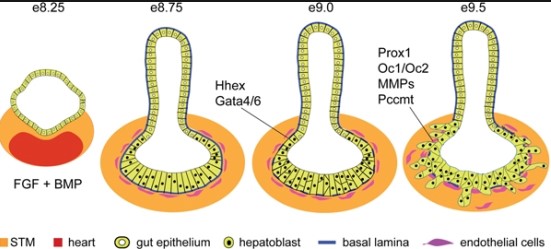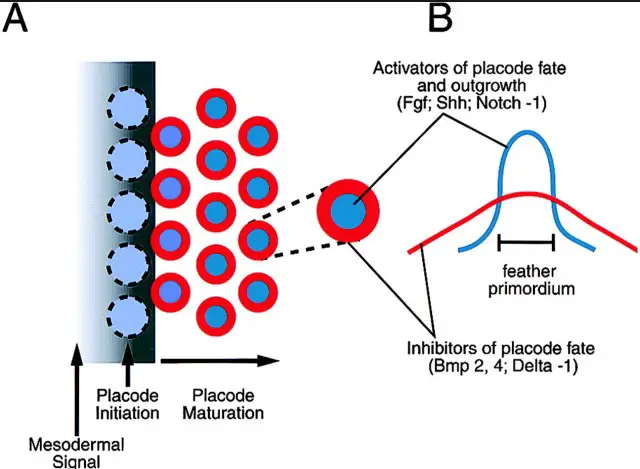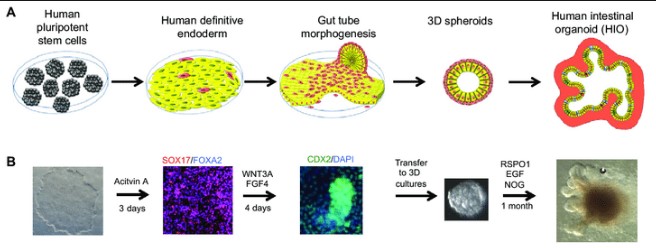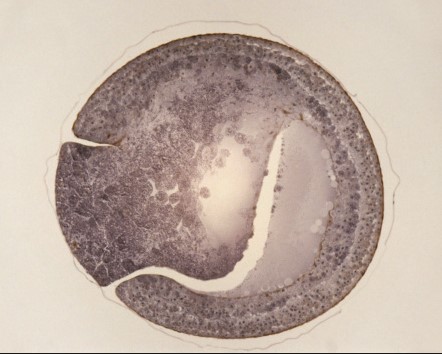In the intricate dance of life, from a single cell to the vast complexity of forms that constitute the biological world, two processes stand at the core: differentiation and morphogenesis. These biological phenomena work in tandem to sculpt the diverse array of living organisms that populate our planet. At their essence, they are about becoming and shaping, respectively—fundamental aspects of how life develops and evolves over time.
Differentiation refers to the process by which cells become specialized in their function, transitioning from pluripotent states to specific types with distinct roles. Morphogenesis, on the other hand, is the biological blueprint that guides the organization of these cells into the complex structures that make up an organism. Together, they create the symphony of life, orchestrating the development from a single cell to a fully formed organism with intricate organ systems and functionalities.
The importance of these processes extends beyond mere academic curiosity. They are pivotal in understanding developmental biology, the genesis of various diseases, and the foundations of regenerative medicine. As we peel back the layers on differentiation and morphogenesis, we uncover not just the mechanics of life but also the potential pathways to healing and regeneration, offering insights into the creation of therapeutic strategies that could one day revolutionize medicine.

Defining the Terms
Differentiation Overview
At the heart of biological development lies differentiation, a process by which unspecialized cells evolve into specialized types with unique functions. This transformation is crucial for the development of multicellular organisms, enabling the complex array of life forms we observe. From the inception of a single fertilized egg, differentiation drives the creation of diverse cell types – from nerve cells to muscle cells, each playing its distinct role within the organism.
The significance of differentiation cannot be overstated. It is the foundation upon which the structure and function of organisms are built. Through this process, cells acquire specific identities and functional capabilities, allowing for the division of labor that is essential to the life of complex organisms. This cellular diversification is the reason we have different tissues and organs, each contributing to the organism’s overall health and functionality.
Morphogenesis Overview
Morphogenesis takes the baton from differentiation, guiding the spatial organization of cells into structured tissues and organs. This process is about shape and form; it dictates how a plant’s leaf unfurls or how an animal’s body takes shape during development. Morphogenesis is governed by a multitude of factors, including genetic instructions and environmental cues, orchestrating the complex dance that leads to the formation of functional biological structures.
The process is both dynamic and adaptive, allowing organisms to develop forms best suited to their environment and lifestyle. Through morphogenesis, cells not only know what to become but also where to position themselves within the organism. This spatial arrangement is crucial for the proper functioning of tissues and organs, enabling the complex interplay that sustains life.
Key Differences
Cellular Focus
Differentiation and morphogenesis differ primarily in their focus and scope. Differentiation zeroes in on the cell, transforming it to perform specific tasks. It’s about cell type and function, setting the stage for the organism’s diverse capabilities. Morphogenesis, on the other hand, is concerned with the broader picture – the assembly of these differentiated cells into coherent structures. It’s about the architecture of life, from the simplest organisms to the most complex.
Genetic Regulation
Both processes are underpinned by genetic factors, but the nature of their regulation and the complexity of their interactions with other biological systems vary significantly. Differentiation is driven by the expression of specific genes that dictate a cell’s fate, turning it from a pluripotent state into a specialized entity. Morphogenesis, while also genetically orchestrated, involves additional layers of regulation, including cell signaling and mechanical forces, to coordinate the large-scale organization of cells.
Environmental Influence
The environment plays a nuanced role in shaping both processes, but its impact on morphogenesis is particularly profound. Environmental factors such as temperature, nutrients, and physical constraints can significantly alter the course of morphogenesis, influencing the shape and size of organs and organisms. Differentiation, though responsive to environmental cues, is more tightly controlled by intrinsic genetic programs and is less directly influenced by external conditions.
Processes in Action
From Stem Cells to Organ Systems
The journey from stem cells to fully formed organ systems is a testament to the intricacies of differentiation and morphogenesis. Stem cells, with their pluripotent capabilities, embark on a path of differentiation, assuming specific roles as muscle cells, nerve cells, or blood cells. This diversification sets the stage for morphogenesis, where these differentiated cells organize into tissues and organs, creating the functional systems that sustain life.
Examples in Nature
The development of the nervous system and the formation of plant structures offer compelling examples of differentiation and morphogenesis in action. In animals, nerve cells differentiate from progenitor cells, then extend axons and dendrites as part of the morphogenetic process to form complex networks essential for sensory and motor functions. Plants, meanwhile, demonstrate morphogenesis in the growth patterns of leaves and stems, where cells differentiate into specific types that contribute to the plant’s overall form and ability to capture sunlight.

Interrelation and Dependency
Interplay Between Processes
The interrelation between differentiation and morphogenesis is not just sequential but deeply interdependent, forming a complex, integrated framework essential for the development of organisms. Differentiation provides the diverse cell types necessary for an organism’s development, while morphogenesis arranges these differentiated cells into functional structures. Without the specialized cells produced by differentiation, morphogenesis would have no building blocks to work with; conversely, without morphogenesis, these cells would not be organized into the structures necessary for organismal life.
This symbiosis ensures that as cells differentiate, morphogenetic signals guide them to their correct locations, enabling the formation of tissues and organs. The spatial context provided by morphogenesis, in turn, influences further differentiation, creating a feedback loop essential for the proper development of complex biological systems.
Impact on Evolution
The processes of differentiation and morphogenesis have profound implications for evolutionary adaptation and species diversity. Variations in these processes can lead to novel structures or functionalities, providing organisms with an evolutionary advantage in their specific environments. For instance, slight changes in the genetic regulation of these processes can result in significant morphological differences, contributing to the diversification of species over time.
This adaptability has been a driving force behind the evolutionary success of multicellular life, allowing for a remarkable range of forms and functions. The diversity of plant and animal life, from the simplicity of a moss to the complexity of a human, showcases the evolutionary power of differentiation and morphogenesis to create organisms uniquely suited to their environments.
Research and Applications
Advances in Biomedical Research
Recent advances in biomedical research have shed new light on the mechanisms underlying differentiation and morphogenesis, offering promising new insights into health and disease. For example, studies have revealed how alterations in these processes can lead to developmental disorders or contribute to the progression of cancer, where cells differentiate abnormally and morphogenesis leads to the formation of tumors.
Moreover, understanding the genetic and molecular basis of these processes has led to breakthroughs in identifying potential targets for new treatments, highlighting the role of specific genes and signaling pathways in various diseases. This research not only deepens our understanding of fundamental biological processes but also paves the way for innovative therapeutic strategies.
Regenerative Medicine and Therapeutics
The application of knowledge about differentiation and morphogenesis in regenerative medicine has opened up new frontiers in treating a wide range of diseases. Stem cell therapy and tissue engineering, for example, leverage these processes to grow healthy tissues in the lab, which can then be used to repair or replace damaged organs.
- Stem cell therapy: Utilizes pluripotent stem cells capable of differentiating into various cell types. By guiding these stem cells to differentiate in specific ways, researchers can generate tissues and cells for transplantation.
- Tissue engineering: Combines scaffolds, cells, and biologically active molecules to create functional tissues. The scaffold provides the structure for cell attachment and tissue development, mirroring the role of morphogenesis in organizing cells into tissues.
These approaches have shown promise in treating conditions ranging from heart disease to spinal cord injuries, illustrating the potential of harnessing differentiation and morphogenesis for therapeutic purposes.
Ethical Considerations
Research Ethics
The manipulation of differentiation and morphogenesis, particularly in human subjects, raises important ethical considerations. While the potential for regenerative medicine and therapeutic applications is immense, it is crucial to address concerns related to safety, efficacy, and access. Ethical frameworks and guidelines are essential to ensure that research and clinical applications proceed in a manner that is respectful of human dignity, rights, and welfare.
Issues such as genetic modification, potential long-term effects, and the equitable distribution of advanced treatments are at the forefront of discussions among scientists, ethicists, and policymakers. Ensuring ethical integrity in this rapidly evolving field is paramount to its success and acceptance by the public.
Future Prospects
The future of biomedical advancements, particularly in understanding and applying differentiation and morphogenesis, holds great promise for revolutionizing medicine and healthcare. As research continues to unveil the intricacies of these processes, the potential for developing more effective treatments for a wide range of diseases and injuries grows.
Speculation abounds about the possibilities, from growing entire organs for transplantation to reversing the effects of degenerative diseases. The ongoing fusion of biology with technology, such as bioinformatics and nanotechnology, further enhances the potential to not just treat but also prevent diseases at their genetic and molecular roots.

Frequently Asked Questions
How do differentiation and morphogenesis interact?
Differentiation and morphogenesis are closely intertwined, with differentiation providing the specialized cells required for morphogenesis to shape these cells into functional tissues and organs. This interplay is crucial for the proper development of organisms, ensuring that cells not only acquire specific functions but are also arranged in a manner that allows them to work together effectively.
Why are these processes important in regenerative medicine?
Understanding differentiation and morphogenesis is vital in regenerative medicine because they are the fundamental processes by which tissues and organs develop. This knowledge can be applied to grow tissues in the lab, develop stem cell therapies, and engineer organs for transplantation, potentially offering new treatments for diseases and injuries that currently have no cure.
Can differentiation occur without morphogenesis?
While differentiation can occur in the absence of morphogenesis, especially in simpler organisms or in vitro conditions, the full development and functionality of complex multicellular organisms require both processes. Differentiation provides the variety of cell types needed, but without morphogenesis to organize these cells into structured tissues and organs, the organism would not be viable.
How does the environment influence morphogenesis?
The environment plays a significant role in morphogenesis by influencing the shape and structure of developing organisms. External factors such as temperature, chemicals, and mechanical forces can affect gene expression and cell behavior, thereby guiding how tissues and organs are formed. This highlights the adaptive nature of morphogenesis in response to environmental conditions.
Conclusion
As we delve into the realms of differentiation and morphogenesis, we find ourselves at the heart of biological development, uncovering the mechanisms that drive the diversity of life on Earth. These processes not only explain how life forms but also open doors to innovative medical treatments through regenerative medicine and stem cell research. By mastering these biological principles, we can pave the way for breakthroughs in treating diseases and injuries, marking a new era in healthcare.
The journey from a single cell to a complex organism is a marvel of nature, underscored by the critical roles of differentiation and morphogenesis. As research continues to unravel the mysteries behind these processes, we stand on the brink of unlocking potential therapies that could transform lives. In this exploration of life’s foundations, we are reminded of the delicate balance and intricate design that underpin our very existence.

